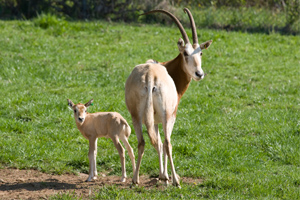
Dama gazelles
Credit: Susan E. Adams CC BY-SA 2.0
On September 2, 2005, the U.S. Fish and Wildlife Service (Service) added three African antelope species to the Federal List of Endangered and Threatened Wildlife under the Endangered Species Act (ESA) — the scimitar-horned oryx, addax, and dama gazelle. At the same time, the Service published a new regulation providing an exclusion from the requirement to obtain a permit or other authorization for carrying out certain otherwise prohibited activities with these three species, such as hunting on a private ranch or game operation.
The Service recognizes the important contribution captive breeding has made to the continued survival of these species, which have been removed from (in the case of the oryx) or greatly reduced in numbers in the wild. Many game ranches within the United States have been breeding and maintaining these species on their properties and, as a result of strong management practices, have offered hunting of these species as a way to manage the size and health of their herds.
However, as a result of a Court ruling, the Service published a final rule on January 5, 2012 to eliminate the regulation that authorized certain otherwise prohibited activities under the ESA with U.S. captive-bred animals and sport-hunted trophies of three endangered African antelope species. The regulation being eliminated had excluded these three antelope species from permitting requirements as long as certain conditions were met.
To read the Federal Register final rule, click here. To read the proposed rule, published on July 7, 2011, click here.
Permit Procedures

Scimitar-horned Oryx with calf
Credit: Smithsonian National Zoo
The new regulation went into effect on April 4, 2012, at which point the three antelope species were treated the same as all other captive-bred endangered species in the United States. Individuals in the United States who possess these three antelope species and wish to carry out otherwise prohibited activities, including interstate or foreign commerce, import, export, culling or other forms of take, must obtain a permit or other authorization from the Service.
The ESA does not prohibit possession. Individuals do not need a permit from the Service for private ownership or breeding. However, it is a violation of federal law to take (cull or kill) any of these three antelope species, unless the primary purpose of such activity is to enhance the propagation or survival of the species and the Service has authorized it. This means that an individual cannot decide to eliminate a herd through lethal means under the misconception that the change in regulation would adversely affect ranching operations.
The Service is actively working to streamline the permitting process and minimize any burden on the public with regard to issuing permits and authorizations for activities under the ESA. Working together we can ensure that United States ranches continue in the long tradition of wildlife conservation for the benefit of these endangered species.
- If you own and breed these animals and you do not need to cull any animals, you do not need a permit.
- If you must cull some of these animals for herd management or engage in interstate commerce of live animals, you should complete application form 3-200-41
 .
. - If you are allowing people to hunt these animals on your property, you should complete application form 3-200-37
 .
.
If you are interested in applying for a permit for the three African antelope species, read the Informational Cheat Sheet on Interstate Commerce and Culling for the Three Antelope ![]() .
.
For more information on permits related to captive-breeding, read the Captive-Bred Wildlife Registration under the Endangered Species Act ![]() factsheet. To learn more about the final rule, read the Captive Breeding of Three Foreign Antelope Species
factsheet. To learn more about the final rule, read the Captive Breeding of Three Foreign Antelope Species ![]() background factsheet and the Myths & Facts
background factsheet and the Myths & Facts ![]() .
.
For general information on CITES permit requirements, click here ![]() .
.

